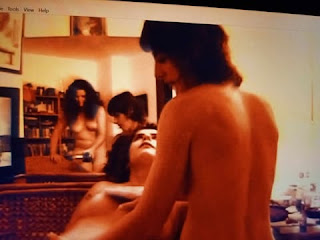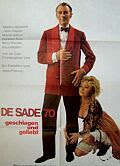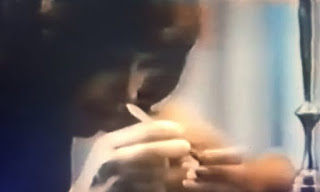29 April, 2025
I love costumed superhero films (especially with spy and science fiction twists) from the 1960s from Gianfranco Parolini's THREE FANTASTIC SUPERMEN to the Japanese giant, ULTRAMAN. Jess Franco's 1967 Eurospy spoof LUCKY, EL INTREPIDO featuring Ray Danton (along with Jess Franco in two amusing cameos). Beside the non-stop quips, delivered in high style by Danton, the element I like most in LUCKY is the typically quirky, high-spirited Bruno Nicolai score (see if you can find it on CD). The main theme, with its crazy vocals and thumping two note refrain is great fun and I never get tired of revisiting it.

Preceded by the frenetic, some might say silly, monochrome spoof, ATTACK OF THE ROBOTS, Franco's second Al Pereira feature, and the somber, underestimated RESEDENCIA PARA ESPIAS, LUCKY is stuffed with visual and verbal gags, and the secret agent protagonist seems in on the joke this time, whereas Eddie Constantine/the characters he plays in ATTACK... and RESDENCIA... seemes baffled by the action and ambiguity surrounding him. Constantine does well with double takes in ATTACK but seems less comfortable with the numerous pratfalls, including the final backward fall off of small fishing boat which ends the film. Godard keeps him straight and sober throughout ALPHAVILLE, except for a few bursts in sudden laughter. When you're a spy in a dystopia you don't have much to smile about.

Franco's first Eurospy thriller, DEATH WHISTLES THE BLUES (1962), is an immersion into a jazz milieu in which the director himself plays the saxophone with the Whisky Jazz band. The nightclub is the site where the musical code, Terrado Blues, is transmitted to those in the know, first by Julius Smith and then by Moira Santos (Danick Pattison), the latter on a secret mission of vengeance. Betrayal of friendship here, as in RESIDENCIA PARA ESPIAS, trumps betrayal of country. The spy spoof sub genre would be a default which Franco would employ into such 1980s efforts as UNA RAJITA PARA DOS (within a hardcore context), SANGRE EN MIS ZAPATOS (1983) and
CUANTO COBRA UN ESPIAS? (1984).

Franco himself appears as a spymaster, Agent 008/Radeck, in the minimalist 1975 spy spoof MIDNIGHT PARTY aka LA COCCOLONA/LADY PORNO, who directs the torture of kidnapped stripper Lina Romay by Monica Swinn and Ramon Ardid. Shot in several hotel rooms at Le Grande Motte, the film is so threadbare that the fact that it's also interactive, at least in it's complete 90 minute version, that the fact that both Romay and Franco break the fourth wall and speak directly to the viewer becomes its most interesting aspect. One can imagine Franco writing down the synopsis on a napkin during a meal at the casino. It opens with the stripteaser Sylvia rolling around naked and taunting the viewer and ends, after interruptions by her hippie boyfriend (Alain Petit) and Franco's favorite detective Al Pereira (Olivier Mathot), with Agent 008 taking off his glasses, turning to camera, and informing the viewer that he is not a spy, but merely an actor in a film.

LADY PORNO [Porno Dama], a Spanish variant of Franco’s original MIDNIGHT PARTY. Julio Perez Tabernero, an actor turned producer-director (he can be seen in Franco’s own SADISTEROTICA/Two Undercover Angels), acquired it for his Titanic Films company (Julio, your company needs a new handle!) and reconstructed it as an «American-Belgian» co-production. It’s very amusingly redubbed and rescored with lewd comments, bawdy music and more direct-to-the-viewer takes.
Sylvia is a very hot stripper who is introduced dancing in a glittering silver costume. Off stage she carries on an affair with a cheap detective, Al Pereira (Olivier Mathot) behind the back of her longtime squeeze Red Nicholas, a Communist musician frenetically embodied by French film historian and Jess Franco friend, Alain Petit . This is not really another of Franco’s Al Pereira episodes, as he is mainly a player in Sylvia’s story. This is kind of like a live action cartoon (cf LUCKY, THE INSCRUTABLE) with Lina Romay giving it all she has as the resourceful Sylvia. This might actually be my personal favorite of her performances, she mercilessly teases the viewer directly as the interactive approach allows her to pose, stick her tongue out, and make alluring remarks to the audience before turning back to the scene and players at hand, resuming in the traditional fourth wall mode. It’s a lot of good natured fun. Except that the subject is torture. Torture that doesn’t draw blood but really hurts!
Sylvia is taken by Radeck/Agent 008 (Jess Franco himself), a spymaster and professional torture mogul who takes his business very seriously indeed. Look at the way he abuses poor Sylvia: after being stripped and sexually abused by henchmen Monica Swinn and Ramon, she’s poked, punched and cigarette burned by the ingrates under the very close supervision of Radeck. They take her to the «torture clinic» which, this being a Jess Franco shoot, merely means another hotel room (or the same hotel room slightly redressed and shot from a different angle). Choosing pliers they try pulling out her toenails, as Radeck is beginning to lose his patience. At this point one of my favorite moments in Franco’s monumental filmography occurs, and it only last a few seconds–Radeck simply puts a cigarette in his mouth and lights it. That’s it! The exact way which actor Jess Franco suddenly jabs the cigarette into his mouth and fires it up has to be experienced first hand. It’s a grand bit a business, something small made into something very special by a seasoned professional. It will bring a smile to the face of all Franco enthusiasts.
Franco drops the Radeck pose at the end, as Sylvia and Al are escaping he faces the camera and admits to us that it was all an illusion, only a movie. It is Jess Franco talking to us now. We have been spectators. But what are we doing at this venue? Of course, that question is implied rather than asked. Alain Petit is very droll as the Marxist jazz singer. Billed as «Charlie Christian» (cf JUSTINE, the 1979-80 Joe D’Amato composite where he is likewise billed. His footage in that and MIDNIGHT PARTY is rolled over with scenes from SHINING SEX into a unique reedit) he performs his infamous «La Vie est une Merde», also heard in a blues rendition during Franco’s 1982 EMMANUELLE EXPOSED and in Petit’s documentary THE MAKING OF TENDER FLESH (1997). The Spanish language version which was screened for this review (subtitled in English) is very much in keeping with the joker/trickster impulses which frequently bubble to the surface of Franco’s work. The finale, a shootout with the cops (a minimalist debacle) followed by shots of birds flying in the distance as our couple floats away on a pleasure craft, is post-ironic in the sense that it delivers on expectations which Franco obviously considers bogus while gleefully curving past the generic demands of representational, grade B sexploitation production methodology. In other words: don’t worry, be happy, it’s only a movie.
Tabernero seems to have simply reedited, cut down, dubbed/ rescored the director’s cut. There is also the 90m THE MIDNIGHT PARTY, in English, which may be the best way to ascertain the director’s intent since it includes the interactive opening in which Lina Romay frolics on a queen size bed while she lasciviously addresses the viewer. The longer version does stretch the very broad humor to its absolute limits. But at least it never crosses over into hardcore terrain.
The gangling Tabernero can be seeAn as a supporting plalyer in such 1960s Eurowesterns as FURY OF THE APACHES (1964), SEVEN GUNS FOR THE MACKENNAS(1965) and in Eurospy titles such as RIFIFI IN AMSTERDAM (1966) as well as in his own SEXY CAT (1972), his best film as a director , a highly entertaining Spanish giallo done in the style of cine-comic strip complete with a black clad villain who kills with long, razor ship fingernails a la Franco’s MISS MUERTE (1965). Private Investigator Al Pereira would appear in more Jess Franco directed features, including his final completed film, AL PEREIRA VS. THE ALLIGATOR LADIES, his ultimate interactive experiment, with the director himself placed at the center of the action.
An equally interactive spy spoof, LES GRANDES EMMERDEUSES (1974), is even more outrageously outre, opening with Lina Romay and Pamela Standford (Monique Delauney) romping around totally naked on queen sized beds in some hotel room, identifying themselves as Interpol agents. Franco's obsession with the "Red Lips", a team of sexy female detectives/secret agents goes all the way back to his second feature film, LABIOS ROJOS (1960). Here they're no longer identified as the Red Lips and they are involved in criminal smuggling of diamonds (guess where they hide them) as they encounter other smugglers, a mad scientist and a grotesque, hairy creature called the Durenstein monster. Filmed in Paris and Portugal, standing in for Istanbul, it's all good fun with Franco returning as another spy master.

There are even spy movie references in the 1980 surreal sex comedy EL SEXO ESTA LOCO, in which sex club performer Lina Romay is questioned about missing plans for an "air-submarine" (a reference to Ishiro Honda's 1963 ATRAGON?). Spy movie formats continue in the Franco-verse with CUANTO COBRA UN ESPIA? (1984) and several supposed Edgar Wallace adaptations including SANGRE EN MIS ZAPATOS (1983) and VIAJE A BANGKOK ATAUD INCLUIDO (1985), along with his straight and sober DARK MISSION (OPERACION COCAINA) (1987), the later starring Christoper Lee, Brigitte Lahie and Chris Mitchum as a CIA agent. I'll be discussing these in a future blog, along with the 1970 THE DEVIL CAME FROM AKASAVA, starring Soledad Miranda as a secret agent in her final film before her untimely death.
(C) Robert Monell 2025























































